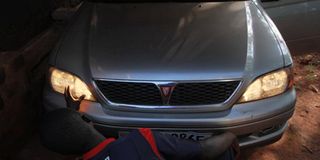Let’s chat :When driving at night becomes a nightmare

Light adjustment can help one have beams that would not affect other drivers. FILE PHOTO
Driving at night with full beams can momentarily “blind” the oncoming drivers, but this is something some people take for granted. Without driving schools doing comprehensive training, these incidents may be on the increase.
Jude: I don’t know whether or not you have found yourself in situation whereby you are driving and someone aims their bright beams at you, you are almost blinded.
Mustafa: Let me stop you right there. Toyota Ipsum drivers. I don’t know whether there is a rule at the bonds that people should drive their Ipsums with full lights!
Jude: Maybe they don’t know how to turn their lights to half beams.
Mustafa: This is very unique to Toyota Ipsums.
Paul: Maybe they have the modern xenon lights.
Jude: No, they just look like xenons but they are not xenons.
Paul: I am talking about light intensity.
Mustafa: These people always drive in full.
Jude: Could it be a factory error?
Mustafa: I don’t know but they always drive with full lights.
Paul: Why are you classifying Ipsum drivers?
Mustafa: No, I am not classifying them. But out of 10 people, when you are driving and “request” the other driver to dim their lights, most of them are Ipsum drivers. I notice this after they have dimmed their lights.
Paul: Have you tried to drive around and see how many Ipsums drive past you? You could easily say the Ipsum is the most popular car in town.
Mustafa: You can look at it that way.
Jude: Or maybe there is something (a button) that they need to turn in a particular way and say most of them don’t know how to do it. And the car manuals are in Japanese, you never know!
Mustafa: That was my own personal experience. I don’t know about other people.
Jude: But when I am blinded, I may end up ramming into someone else.
Paul: This has to do with driver training and courtesy. You have got to have some common sense to know that when you drive with high beams, you not only endanger oncoming traffic but for yourself as well. Secondly, you need to have courtesy that –oh I am hurting the other driver. Sometimes I catch myself using high beams and I remember that I am actually blinding the other person. Sometimes you may need to highlight an object on the road so you use the high beams.
Mustafa: But the manufacturer shows you that you are in high beams when some blue light comes on in your instrument panel. When you are setting your lights, they are set in such a way that the right headlamp will always be a bit lower than the left one. The setting is that even when you put high beams you are not blinding the person on the other side. In fact newer cars have sensors. So when they see an oncoming car, they automatically lower your lights. In the US and Europe, you can be arrested for driving in high beams.
Jude: Here, our people are oblivious. But maybe it is because our driving schools don’t have night driving included in their sessions.
Paul: One of the problems we have is the nature of our trainings. We lack a comprehensive driver training manual. For instance, in the UK besides the Highway Code, they have a special driver training manual. In Uganda, we tried to upgrade it. I think we now have written exams. But in the past, it wasn’t there. We lack a comprehensive manual that can give you the A, B, C of driving and it includes night driving. I think our schools don’t take into consideration night driving. As long as one can put their feet on the pedals that is it.
Mustafa: Someone can even ask a funny or silly question that do you even know when you are in high beams or not? For them, there is no difference. What is high or low, they may ask? There is a lot of training that is needed. Some people haven’t seen direct consequences of driving with high beams.
Jude: The consequences are that you kind of impair my sight and I just cannot move.
Mustafa: Exactly, but what are the consequences of me? (using the high beams against you), there is none. I will drive on.
Paul: Have you seen drivers whose low is quite bright?
Mustafa: The xenon lamps are factory set to high or low. They have anti-glare. The problem is that when people do conversions, the retrofit- whereby I want my AE100 (Kikumi) to look so nice I may put the xenons. The biggest issue is that me (who is using the high beam) there is no consequence for me. It goes back to courtesy and training.
Jude: The bigger factor here should be to include night driving sessions in our training schools.
Mustafa: Jude, did you go to a training school?
Jude: I did.
Mustafa: Paul, did you go?
Paul: I did not attend any here but I went to one in the UK, to get the UK driving license. Here, I got someone to give the A,B,C,D of passing the driving test in Naguru.
Jude: So you are the people we are dealing with here?
Paul: I had formal driver training in the UK.
Mustafa: But how many people are in that category?
Paul: But seriously, we need a better driver training manual. We need road courtesy and the drivers need to know the consequences of glaring their beams at oncoming traffic. Besides other people, you are also at risk.




